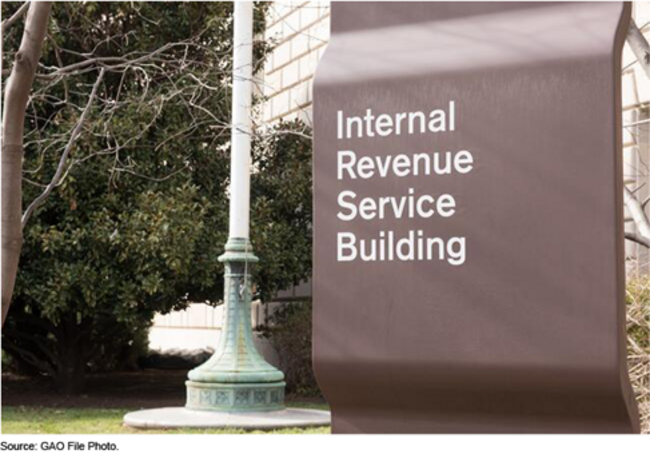Taxpayer Experience: IRS Should Fully Establish Its Approach for Using Evidence to Assess Service Improvement Results
Fast Facts
IRS has struggled to improve how taxpayers experience IRS services. The Inflation Reduction Act provided funding to improve IRS operations, including these services.
We found that IRS was implementing a strategy to improve taxpayer services that included more than 150 projects. Such projects were intended to improve live assistance, online services, and more. But IRS hadn’t decided how to assess whether these projects improved the taxpayer experience.
In light of recent funding and staffing reductions, IRS is reassessing these projects. We recommended using evidence to assess how IRS’s service improvement projects affect the taxpayer experience.

The IRS building sign
Highlights
What GAO Found
As of February 2025, the Internal Revenue Service (IRS) had been implementing a strategy to improve taxpayer services with Inflation Reduction Act (IRA) funds. IRS developed two strategic objectives aligned with a range of service improvement projects. These included efforts such as to
- improve access to live assistance on the telephone and in person, and
- expand features that allow taxpayers to perform interactions online.
GAO interviewed 10 selected groups that represent taxpayers about what they want and need from IRS. These included clear guidance and tools. IRS officials described ongoing or planned actions to address these wants and needs, such as simplifying taxpayer notices and providing IRS staff computer systems and data to help taxpayers. In March 2025, however, IRS said it is reassessing which IRA projects to continue because of changes in IRS funding and staffing levels.
IRS's efforts to improve the taxpayer experience have been spurred by statutory requirements, including IRS's Taxpayer Experience Strategy as required by the Taxpayer First Act of 2019. IRS has acted to follow Office of Management and Budget (OMB) guidance for high-impact service providers, including developing annual plans to improve priority services. IRS faces challenges in demonstrating that it has improved the taxpayer experience, such as limited data and measures, uncertain funding and staffing levels, and changes in complex tax laws. IRS officials outlined efforts to address these challenges, such as developing new measures, data, and tools on how taxpayers experience IRS services.
IRS documents state that these service improvements are intended to improve the taxpayer experience. For example, its 2023 strategic plan said IRS would make it easier for taxpayers to meet their tax responsibilities and receive tax incentives for which they are eligible. IRS has also taken some actions to develop and use evidence to assess progress in improving services but has not fully established an evidence-based approach such as by using 13 key practices GAO has identified to determine the effects of these efforts on the taxpayer experience. For example, IRS has not fully established key practices to:
- define taxpayer experience goals related to service improvements;
- generate new evidence from measures, analytical tools, and dashboards to track progress with the taxpayer experience goals;
- involve external stakeholders to help assess the effects of its service improvements on the taxpayer experience; and
- promote accountability for achieving the taxpayer experience goals.
IRS officials said establishing an evidence-based approach using these and other key practices has been delayed. The IRS offices that had been coordinating IRA and taxpayer experience initiatives were disbanded in March 2025 and April 2025, respectively, according to IRS officials. As IRS reorganizes and reassesses priorities, integrating all key practices in an evidence-based approach can inform decisions to make the best use of resources in improving the taxpayer experience.
Why GAO Did This Study
IRS has struggled with long-standing challenges in improving how taxpayers experience interacting with IRS services. Policymakers have recognized the critical importance of improving taxpayer services IRS provides, as well as the related taxpayers' experience in using the services. IRA provided IRS tens of billions of dollars over 10 years for improving operations, including services to taxpayers.
The IRA includes a provision for GAO to oversee the distribution and use of IRA funds. This report (1) describes IRS's plans and actions to improve services to meet taxpayer wants and needs, (2) describes IRS's plans and actions to improve the taxpayer experience and overcome related challenges, and (3) evaluates whether IRS is assessing how service improvement efforts have improved the taxpayer experience using evidence.
GAO reviewed IRS documents and interviewed IRS officials and relevant stakeholders, including members of 10 selected groups that represent taxpayers. GAO also compared IRS's strategic plans, projects, and other documents to federal guidance, including federal statutes, OMB guidance, and practices that GAO had identified to help agencies build and use evidence to manage performance.
Recommendations
GAO recommends that IRS fully establish an evidence-based approach to determine the effects of service improvements on the taxpayer experience. IRS agreed with the recommendation and outlined planned steps to implement it.
Recommendations for Executive Action
| Agency Affected | Recommendation | Status |
|---|---|---|
| Internal Revenue Service | We recommend that the Commissioner of Internal Revenue fully establish an evidence-based approach, such as we identified, to determine whether and how improvements to services affect the taxpayer experience. (Recommendation 1) |
When we confirm what actions the agency has taken in response to this recommendation, we will provide updated information.
|
